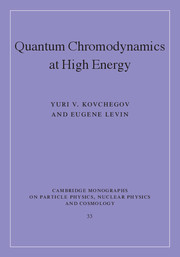Book contents
- Frontmatter
- Contents
- Preface
- 1 Introduction: basics of QCD perturbation theory
- 2 Deep inelastic scattering
- 3 Energy evolution and leading logarithm-1/x approximation in QCD
- 4 Dipole approach to high parton density QCD
- 5 Classical gluon fields and the color glass condensate
- 6 Corrections to nonlinear evolution equations
- 7 Diffraction at high energy
- 8 Particle production in high energy QCD
- 9 Instead of conclusions
- Appendix A Reference formulas
- Appendix B Dispersion relations, analyticity, and unitarity of the scattering amplitude
- References
- Index
3 - Energy evolution and leading logarithm-1/x approximation in QCD
- Frontmatter
- Contents
- Preface
- 1 Introduction: basics of QCD perturbation theory
- 2 Deep inelastic scattering
- 3 Energy evolution and leading logarithm-1/x approximation in QCD
- 4 Dipole approach to high parton density QCD
- 5 Classical gluon fields and the color glass condensate
- 6 Corrections to nonlinear evolution equations
- 7 Diffraction at high energy
- 8 Particle production in high energy QCD
- 9 Instead of conclusions
- Appendix A Reference formulas
- Appendix B Dispersion relations, analyticity, and unitarity of the scattering amplitude
- References
- Index
Summary
We now begin the presentation of our main subject: high energy QCD, also known as small-x physics. We argue that at small Bjorken x it is natural to try to resum leading logarithms of 1/x, that is, powers of αs ln 1/x. Resummation of this parameter in the linear approximation corresponding to low parton density is accomplished by the Balitsky–Fadin–Kuraev–Lipatov (BFKL) evolution equation, which we describe in this chapter using the standard approach based on Feynman diagrams. Note that our derivation of the BFKL equation in this chapter is rather introductory in nature; a more rigorous re-derivation employing LCPT is left until for the next chapter. We point out some problems with the linear BFKL evolution; in particular we argue that it violates unitarity constraints for the scattering cross section. We describe initial attempts to solve the BFKL unitarity problem by introducing nonlinear corrections to the BFKL evolution, resulting in the Gribov–Levin–Ryskin and Mueller–Qiu (GLR–MQ) evolution equation. We discuss properties of the GLR–MQ evolution equation and, for the first time, introduce the saturation scale Qs.
Paradigm shift
Our goal in this book is to study the high energy behavior of QCD. In the context of DIS the high energy asymptotics can be explored by fixing the photon virtuality Q2 and taking the photon–proton center-of-mass energy squared ŝ to be large. In this limit the Bjorken-x variable becomes small, as follows from Eq. (2.6).
- Type
- Chapter
- Information
- Quantum Chromodynamics at High Energy , pp. 74 - 122Publisher: Cambridge University PressPrint publication year: 2012

